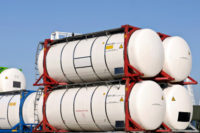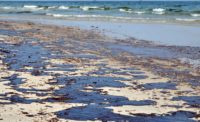On August 12, 2015, in the Chinese port city of Tianjin, a warehouse owned by a logistics company suffered massive explosions and fires that killed at least one hundred people, injured hundreds more, and released toxic fumes into the air. Understandably, the explosion has raised concerns from regulators, industry, and citizens alike about chemical safety here in the United States.
By understanding the chemicals involved in the tragic Tianjin incident, and the legal requirements surrounding the chemicals’ storage, use, and transport within, into, and out of the United States, we can get a sense of how US regulatory agencies and industry work together to protect the public from these types of disasters.
What chemicals were involved?
The Tianjin Tanggu Environmental Monitoring Station reports that the logistics company that owns the warehouse was storing at least two specific hazardous chemicals there: Sodium cyanide (NaCN) and toluene diisocyanate (TDI).
Sodium cyanide is highly toxic—inhalation, ingestion, or contact with skin or eyes can cause severe injury, lung damage, choking, burns, and even death. When introduced to water, acid, or acid fumes, sodium cyanide can produce toxic and flammable gases, like hydrogen cyanide. Mixing metal cyanides with metal chlorates can cause a violent explosion, and containers of sodium cyanide can explode when heated or contaminated with water.
TDI is a chemical intermediate often used in production of polyurethane products like foams and coatings. In addition to causing skin and eye irritation if inhaled, TDI can cause decreased lung function and other negative reactions in the respiratory and central nervous systems.
Some reports state calcium carbide (CaC2) was present at the facility. Calcium carbide is also an inhalation hazard, and can react violently with water and produce flammable, explosive acetylene gas.
EPCRA inventory reporting for hazardous chemicals
Under the EPA’s Emergency Planning and Community Right-to-Know Act (EPCRA), facilities that use, manage, or store large volumes of hazardous chemicals like those stored at the Tianjin facility must submit annual inventory reports to local authorities.
Any chemical that requires a Safety Data Sheet under OSHA’s Hazard Communication Standard (29 CFR 1200.1910), or HCS, is subject to the EPCRA reporting requirements.
For most substances, the inventory ”threshold planning quantity” is 10,000 lbs. This means that if a facility has 10,000 lbs. or more of a hazardous chemical on site at any one time, it must report to local emergency responders. This way, emergency responders know what’s in store when they are called to respond and can act accordingly. The rules for chemical inventory reporting under EPCRA can be found at 40 CFR 355.
NaCN and TDI are not like “most substances”
Some chemical substances are more dangerous than others. Appendices A and B to 40 CFR 355 list “extremely hazardous substances” for which threshold planning and release quantities can be significantly lower. Both sodium cyanide and toluene diisocyanate appear in Appendix A.
Sodium cyanide (NaCN) has a threshold planning quantity of just 100 lbs.
TDI has a threshold planning quantity of 500 lbs.
Reporting releases of NaCN and TDI
EPA’s EPCRA regulations also include standards for reporting releases of hazardous chemicals. Because NaCN and TDI are both found on the Appendix A list of “extremely hazardous substances,” a release of any amount of these substances must be reported under EPCRA.
A second major EPA program that regulates hazardous chemical releases is the Comprehensive Environmental Response, Compensation, and Liability Act (CERCLA). Commonly known as “Superfund,” this 1980 law authorizes EPA to respond to releases that threaten public and/or environmental health.
The text of the CERCLA regulations provides a reportable quantity, or RQ, for each regulated hazardous substance. Generally speaking, the lower the RQ, the more hazardous EPA deems the chemical in question. For some of the “less hazardous” Appendix A substances, the RQ may be as high as 5,000 or even 10,000 lbs.
For sodium cyanide, the RQ is just 10 pounds. For toluene diisocyanate, the RQ is 100 pounds. These low RQs show the severity of an NaCN or TDI release and the relatively small amount of these substances that can threaten the public or the environment.
US DOT and IATA hazmat shipping rules
When shipped in the United States, both sodium cyanide and toluene diiocyanate are regulated as Division 6.1 hazardous materials (poisons) shipped as UN 3414 (NaCN) and UN 2078 (TDI).
The table of hazardous materials at 49 CFR 172.101 lists four entries four sodium cyanide—three solutions of varying potency (Packing Groups I, II, and III) and an entry for ”Sodium cyanide, solid” (UN1689).
The IATA Dangerous Goods Regulations (DGR), the manual used by hazmat air shippers and air carriers, lists sodium cyanide, solid and sodium cyanide solution. The most potent forms of NaCN—the solid form and the Packing Group I solution—are forbidden from shipment as a limited quantity aboard aircraft. Strict quantity limits apply as well, as low as 5 kilograms or 1 liter per package for PG I shipments.
Under the IATA rules, air shipments of TDI on passenger planes are limited to 5 L per package.
Why chemical regulations are critical
These are only some of the chemical reporting, emergency preparedness, and transportation regulations that apply to these two hazardous chemicals in the US. There are a bevy of other rules that apply to both sodium cyanide and toluene diisocyanate at various stages of their manufacture, distribution, storage, transport, and use.
By knowing how US EPA, US DOT, and international transport regulations deal with these highly hazardous substances, we can understand the severe hazards they pose, and help facilities and emergency responders prepared to respond efficiently and safely.



